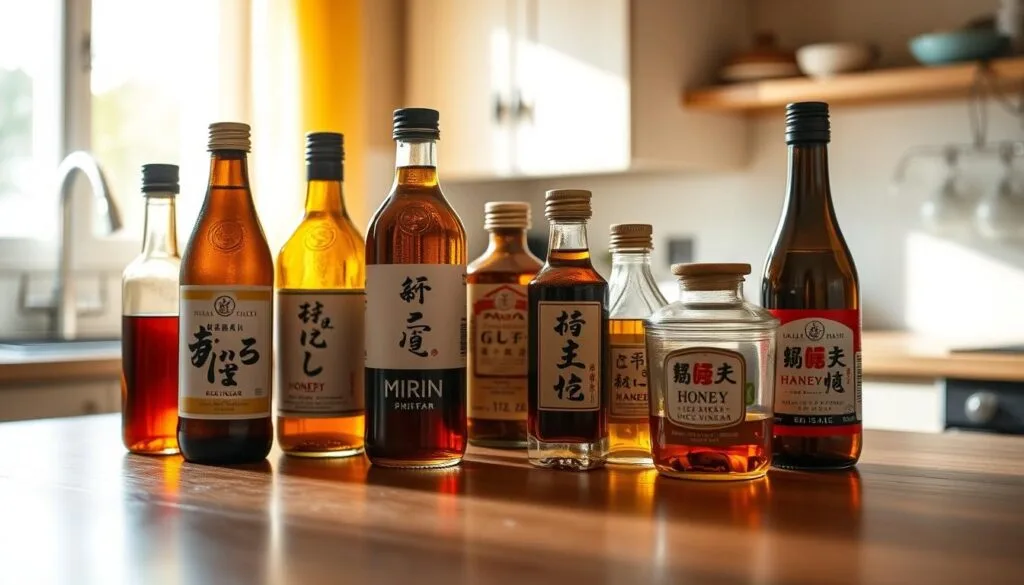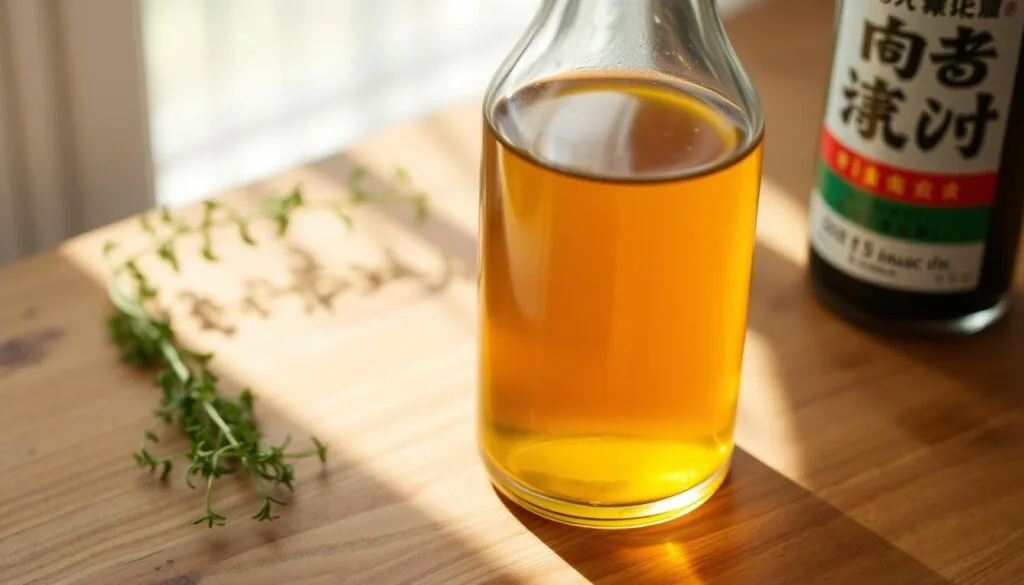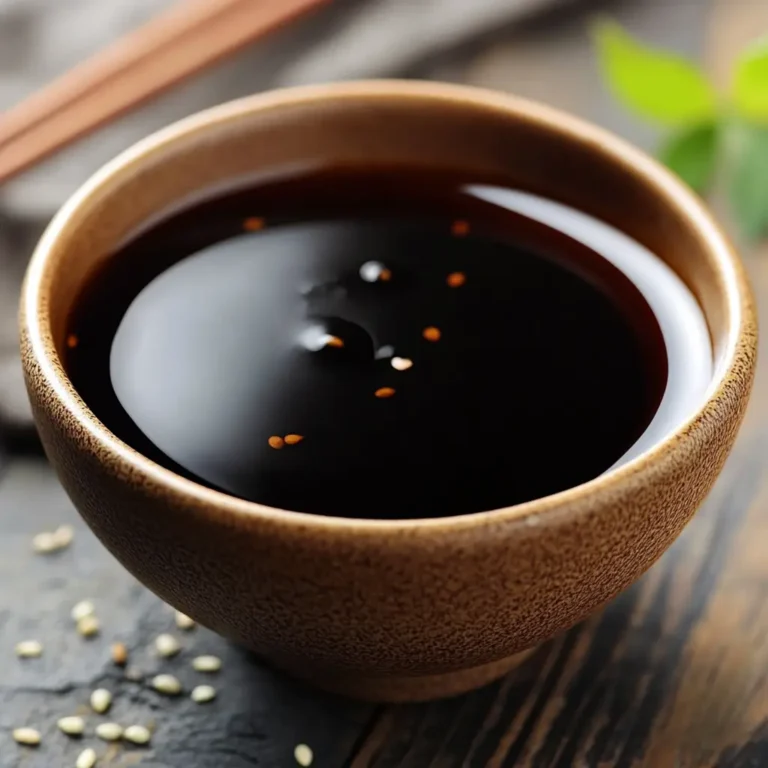Discover the Perfect Mirin Substitute: mirin substitute
I remember my first try at cooking a Japanese dish without mirin. I searched for a substitute and found many options. Mirin is a sweet Japanese rice wine that adds flavor to dishes. But, it’s hard to find, so having a good substitute is key.
We’ll look at the best mirin substitutes like sake, sherry, and rice vinegar. These can help you cook without mirin. You can use them in stir-fries and sauces.
Understanding mirin substitutes is crucial. It lets you try new flavors and recipes. Whether you’re experienced or new to cooking, the right substitute can enhance your dish.
We’ll explore mirin substitutes, from sake and sherry to white grape juice and apple cider vinegar. Each has its own unique qualities. This knowledge helps you choose the best substitute for your recipes.
Table of Contents
Understanding Mirin: The Essential Japanese Cooking Wine
Mirin is a special ingredient that brings sweetness and depth to dishes. It’s made from fermented rice and has a unique taste. Knowing what mirin is like is key when looking for a substitute.
Brands like Fukuraijun Hon Mirin and Hinode Hon Mirin are available abroad. They offer top-notch mirin for Japanese cooking. If you can’t find mirin, try mixing sake and sugar as a substitute.
Mirin is crucial in Japanese cooking, used in sauces and marinades. It’s a main part of teriyaki, eel, and ponzu sauces. Finding the right substitute for mirin is important for making authentic Japanese dishes.
What Makes Mirin Unique
Mirin’s uniqueness comes from its fermentation, lasting 40 to 60 days. This process creates its distinct taste and smell. It also adds to its sweetness and umami.
Key Flavor Components of Mirin
Mirin’s flavor includes sweetness, umami, and a bit of acidity. These elements make it vital in Japanese cooking. When looking for a substitute, focus on these flavors.
Traditional Uses in Japanese Cuisine
Mirin is used in many Japanese dishes, like teriyaki and eel sauces. It’s also a marinade for grilled meats and a seasoning for simmered dishes. Knowing its traditional uses can help you use mirin in new ways.
Best Mirin Substitute Options for Your Kitchen
Looking for a mirin swap? You have many options. You can use common items found in your kitchen. Sake, sherry, and rice vinegar are great substitutes. Each has its own flavor and uses.
To swap mirin successfully, know the flavor and uses of each substitute. For instance, sake can replace mirin 1:1, but add 1 teaspoon of sugar for sweetness. Rice vinegar should be used half the amount of mirin, with 1 teaspoon of sugar for every tablespoon.
Here are some popular mirin substitutes:
- Sake: Use as a 1:1 replacement, with an additional 1 teaspoon of sugar per tablespoon of sake
- Rice vinegar: Use at half the amount of mirin called for, with 1 teaspoon of sugar added per tablespoon of vinegar
- Sherry: Use at half the amount of mirin called for, with sugar added to taste
Knowing the different mirin substitutes and their uses helps you make a great swap. Whether you choose sake, rice vinegar, or sherry, the key is to experiment. Find the mix that works best for you.
| Mirin Substitute | Replacement Ratio | Sugar Addition |
|---|---|---|
| Sake | 1:1 | 1 teaspoon per tablespoon of sake |
| Rice Vinegar | 1:2 | 1 teaspoon per tablespoon of vinegar |
| Sherry | 1:2 | Sugar added to taste |
Sweet Rice Wine Alternatives
Exploring mirin flavors means looking at sweet rice wine alternatives. These can mimic mirin’s taste in recipes. They offer a similar flavor without needing actual mirin.
A mix of sake and sugar is a popular choice. It brings a sweet and savory taste. Rice wine vinegar with honey adds sweetness and a bit of acidity. Chinese Shaoxing wine offers a rich, complex flavor.
These options work well in many dishes, like stir-fries and marinades. They can make your meals taste better. Trying different sweet rice wine alternatives helps you find the best mirin dupes for your taste.
- Sake and sugar combination: sweet and savory flavor
- Rice wine vinegar with honey: sweet and acidic flavor
- Chinese Shaoxing wine: rich and complex flavor profile
Knowing the unique traits of these alternatives helps you choose the right mirin dupes. This way, you can make dishes that taste authentic and delicious.
Everyday Pantry Items as Mirin Replacements
Looking for a mirin substitute? Check your pantry. Sugar, honey, and rice vinegar can do the trick. They offer a similar flavor to mirin, but it’s not an exact match.
I often use these pantry items when I need a mirin substitute. For instance, mix 1 tablespoon of rice vinegar with 1 teaspoon of sugar. This combo is close to mirin and adds sweetness and acidity to dishes.
Here are some pantry items you can use as mirin replacements:
- Sugar: Use 1 tablespoon of sugar as a substitute for 1 tablespoon of mirin, but it lacks mirin’s acidity and depth.
- Honey: Honey can replace mirin, but use 1 tablespoon of it. It’s sweeter and has a stronger flavor.
- Rice vinegar: Mix rice vinegar with sugar to make a mirin substitute. Use 1 tablespoon of rice vinegar and adjust sugar to taste.

These alternatives work in many dishes, like stir-fries, marinades, sauces, and braising liquids. They don’t perfectly match mirin’s flavor but can get you close. Using these pantry items lets you add depth and complexity to your cooking without needing Japanese cooking wine.
| Mirin Substitute | Ratio | Notes |
|---|---|---|
| Sugar | 1:1 | Lacks acidity and depth of flavor |
| Honey | 1:1 | Stronger flavor, can make dish more sweet |
| Rice Vinegar + Sugar | 1 tablespoon rice vinegar : 1 teaspoon sugar | Adjust amount of sugar to taste |
Non-Alcoholic Mirin Substitutes
Looking for a mirin replacement? You’ll want to find non-alcoholic options. These alternatives offer a similar taste to mirin but without alcohol. You can try white grape juice, apple cider vinegar, or simple syrup as a mirin substitute.
These options work well in many dishes, like sauces and marinades. For instance, mixing white grape juice with sugar makes a sweet sauce. Or, apple cider vinegar and sugar add a tangy flavor.
White Grape Juice Solution
White grape juice is a great mirin replacement. Mix it with sugar and water to get a sweet, savory flavor like mirin.
Apple Cider Vinegar Blend
Apple cider vinegar is another mirin substitute. Mix it with sugar and water for a tangy, sweet taste.
Simple Syrup Alternatives
Simple syrup is also a mirin replacement. Mix sugar and water for a sweet flavor. You can add honey or maple syrup for a unique taste.
When using these substitutes, think about the flavor you want. Try different mixes to find the best mirin replacement for your dish. These alternatives let you make tasty dishes without mirin.
Measurement Conversions When Using Mirin Substitutes
When you make a mirin swap, knowing the measurement conversions is key. The ratio of mirin to substitute can change based on the recipe and the substitute. For example, if you use rice vinegar, mix 1 tablespoon with 1/2 teaspoon of sugar.
To make a good mirin swap, sake is a great substitute, mixed with 1/2 teaspoon of sugar. You can also use honey, maple syrup, or agave. For instance, 1 tablespoon of sake can be mixed with 1/3 teaspoon of honey or 1/2 teaspoon of maple syrup.
When using mirin ingredients as substitutes, balancing sweetness and acidity is important. Add sweeteners a little at a time and taste as you go. By knowing the right ratios, you can make a great mirin swap and enjoy Japanese dishes with confidence.
- 1 tablespoon of rice vinegar mixed with 1/2 teaspoon of sugar
- 1 tablespoon of sake paired with 1/2 teaspoon of granulated sugar
- Alternative sweeteners like honey, maple syrup, or agave with their respective ratios
By following these tips and using the correct measurement conversions, you can make a smooth mirin swap. This way, you can enjoy the flavors of Japanese cuisine without losing taste or quality.
Tips for Adapting Recipes Without Mirin
When you’re cooking without mirin, it’s key to think about the mirin flavors it adds. Mirin has a sweet and slightly acidic taste. Finding the right mirin dupes can be tricky, but it’s doable with some trial and error.
To get the right balance, mix sweet rice wine or dry sherry with sugar or honey. For mirin substitutes, use sweet sake and dry sherry in a 1:1 ratio. In stir-fries, mix sweet rice wine with sugar or honey, adjusting the amounts to taste.
Balancing Sweetness and Acidity
Here are some tips for balancing sweetness and acidity with mirin dupes:
- Start with a small amount of sweetener and adjust to taste
- Combine sweet rice wine or dry sherry with sugar or honey to replicate mirin’s flavor profile
- Use pineapple juice as a mirin substitute with a flexible adjustment of quantity based on taste preferences
Adjusting Cooking Times
Using mirin dupes might require adjusting cooking times. For instance, sweet wines like Riesling or Gewürztraminer cook faster to avoid sweetness. Dry sherry or sake might need longer cooking to blend flavors well.
By following these tips and experimenting with mirin dupes, you can make tasty dishes without mirin. Always taste and adjust as you go. Don’t hesitate to mix ingredients to find the perfect balance of sweet and sour.
| Mirin Substitute | Substitution Ratio | Notes |
|---|---|---|
| Sweet Sake | 1:1 | Use in place of mirin for similar flavor profile |
| Dry Sherry | 1:1 | Use in place of mirin for similar flavor profile |
| Pineapple Juice | Flexible | Adjust quantity based on taste preferences |
Common Mistakes to Avoid When Substituting Mirin
When using a mirin substitute, it’s key to avoid common mistakes. These can change the flavor and quality of your dish. One big error is using too much or too little of the substitute. This can mess up the flavor balance in your recipe.
To avoid this, knowing the characteristics of different mirin alternatives is crucial. For instance, if you’re using a sweeter sake, you might need to cut down on sugar in the recipe. But if you’re using a drier sake, you might need to add a bit more sugar to balance the flavors.
Here are some common mistakes to avoid when substituting mirin:
- Using too much or too little of the substitute
- Not adjusting the recipe to account for the characteristics of the substitute
- Not considering the flavor profile of the dish and how the substitute will affect it

By being mindful of these potential pitfalls, you can make sure your dishes are delicious and authentic. Even when using a mirin alternative, your dishes will still taste great.
Conclusion: Making the Most of Your Mirin Alternatives
There are many ways to replace traditional mirin in cooking. You can choose from sweet rice wine blends, non-alcoholic pantry staples, or halal-certified products. The important thing is to experiment and find the right flavor balance for your dishes.
Knowing the unique qualities of each mirin substitute is key. They vary in sweetness and acidity. This knowledge lets you adjust recipes and make dishes that taste just like the originals. Feel free to mix different substitutes to create your ideal mirin replacement.
With a bit of practice, you’ll make sauces, marinades, and glazes as good as those made with mirin. So, start exploring and find out what to use instead of mirin. Your taste buds and guests will love it.







